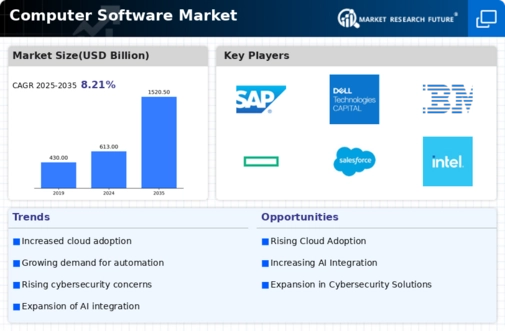Growing Cybersecurity Concerns
Cybersecurity concerns are increasingly influencing the Computer Software Market, as organizations prioritize the protection of sensitive data. With the rise in cyber threats, there is a growing demand for software solutions that enhance security measures. The cybersecurity software market is projected to grow at a compound annual growth rate of approximately 10% over the next few years. Companies are investing in advanced security software to safeguard their networks and data from breaches. This trend is prompting software developers to innovate and create more robust cybersecurity solutions, including threat detection, encryption, and identity management tools. As businesses recognize the importance of cybersecurity, the Computer Software Market is likely to experience sustained growth driven by the need for enhanced security measures.
Rising Importance of Data Analytics
Data analytics emerges as a critical driver within the Computer Software Market. Organizations are increasingly recognizing the value of data-driven decision-making, leading to a heightened demand for analytics software. The market for data analytics solutions is expected to expand significantly, with estimates suggesting a growth rate of around 20% annually. This growth is attributed to the need for businesses to derive actionable insights from vast amounts of data. As companies strive to enhance operational efficiency and customer engagement, the integration of advanced analytics tools becomes paramount. The Computer Software Market is witnessing a proliferation of software solutions that offer predictive analytics, business intelligence, and data visualization capabilities, enabling organizations to make informed decisions and stay competitive.
Emergence of Subscription-Based Models
The Computer Software Market is increasingly shifting towards subscription-based models, which offer flexibility and cost-effectiveness for consumers. This trend is particularly evident in software-as-a-service (SaaS) offerings, where users pay a recurring fee for access to software applications. The subscription model allows companies to provide continuous updates and support, enhancing customer satisfaction. Recent statistics indicate that the SaaS market is projected to reach a valuation of over 300 billion dollars by 2025. This shift not only benefits consumers through lower upfront costs but also provides software developers with a steady revenue stream. As businesses continue to embrace this model, the Computer Software Market is likely to see further innovation and diversification in software offerings.
Integration of Artificial Intelligence
The integration of artificial intelligence (AI) is transforming the Computer Software Market, as businesses seek to leverage AI capabilities to enhance their software solutions. AI technologies, such as machine learning and natural language processing, are being incorporated into various software applications, enabling automation and improved user experiences. The AI software market is anticipated to grow significantly, with projections indicating a compound annual growth rate of around 25% in the coming years. This growth is driven by the increasing demand for intelligent software that can analyze data, predict trends, and automate routine tasks. As organizations strive for efficiency and innovation, the Computer Software Market is likely to see a proliferation of AI-driven software solutions that cater to diverse business needs.
Increased Demand for Remote Work Solutions
The Computer Software Market experiences a notable surge in demand for remote work solutions. As organizations increasingly adopt flexible work arrangements, software that facilitates collaboration, communication, and project management becomes essential. According to recent data, the market for remote work software is projected to grow at a compound annual growth rate of approximately 15% over the next five years. This trend indicates a shift in how businesses operate, necessitating robust software solutions that support remote teams. Companies are investing in tools that enhance productivity and streamline workflows, thereby driving growth within the Computer Software Market. The emphasis on user-friendly interfaces and integration capabilities further fuels this demand, as organizations seek to optimize their operations in a remote work environment.

















Leave a Comment